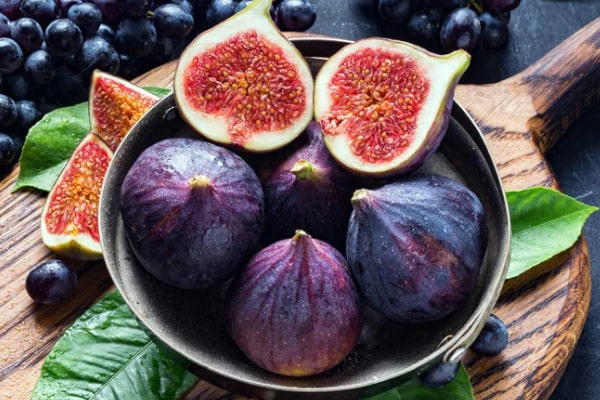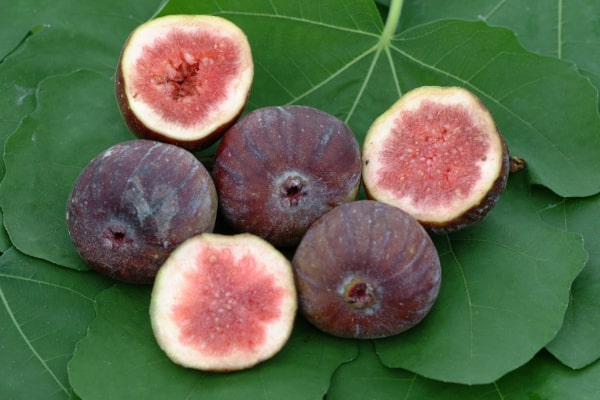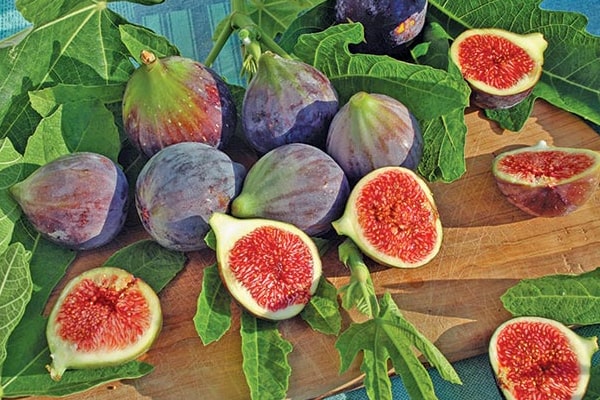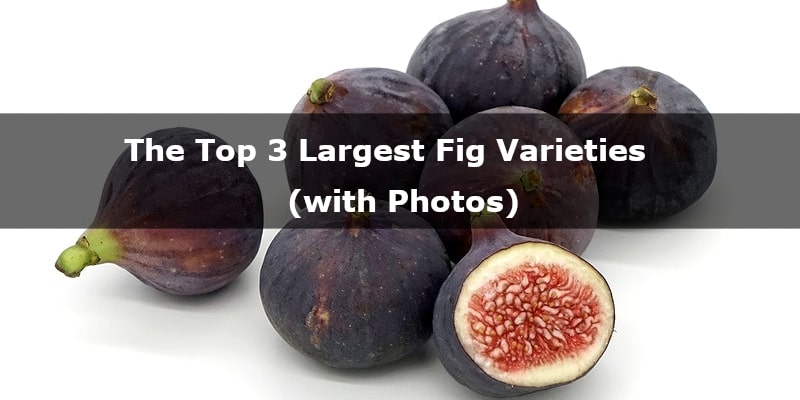Figs are beautiful, delicious, and easy to grow at home. Although many people get intimidated by the idea of growing a tree at home, the process is not difficult at all.
There are over 700 varieties of fig trees. In this article, I’ll share the three largest fig variety options. We will also look at their sizes, fruits’ taste, maintenance, and nurturing needs.
Let’s dive in.
What are the Largest Fig Tree Varieties?
With a fruit size ranging from 1 to 4 inches (2 to 10 centimeters) and tree size of 10 to 40 feet (3 to 12 meters), Black Mission, Brown Turkey, and Chicago Hardy are classified as the largest fig tree varieties.
Fig trees thrive in long summers, intense sunshine, and well-drained soil modified with compost or other organic material.
Although these trees usually flourish in warm areas, with the right care, certain types can also work well in cooler climates.
In this section, we’ll take a look at the three largest fig varieties with slightly different requirements.
1. Black Mission

Black Mission — one of the largest fig varieties with 10 to 40 feet tall (3 to 12 meters) trees that produce dark purple fruit with a sweet berry-like taste and jammy texture two times a year.
First introduced to the US in 1768, Black Mission has become one of the most popular edible fig tree varieties. It produces fruits twice a year, a breba crop in spring and the second main crop in late summer or early fall.
The fruits are medium to large-sized, and the tree thrives in hot, dry regions. The color of this fruit is dark purple and it has a delectable flavor akin to sweet berries.
Black Mission figs are usually between 1 to 2 inches (2 to 5 centimeters) in size and weigh approximately 40 grams (0.08 pounds).
Although the taste of these figs is not overly sweet, it is definitely rich with a pleasant jammy texture inside. Hence, you can use them for snacks, cakes, jellies, and jams.
For people who want to grow a fruit tree at home, this variety is ideal since it is filled with nutritional value and has a fine flavor.
It is also an ideal choice for your backyard as a shade tree since a Black Mission Fig tree typically grows between 10 and 40 feet (3-12 m) tall and 60 feet (18 m) wide.
Care Instructions for Black Mission
- Like most fig varieties, Black Mission grows well in dry, hot summer and mild winter. It ripens during the late summer and early fall.
- In the US, it grows best in USDA plant hardiness zones 7 through 10, where the lowest temperature does not go below 10-15 degrees Fahrenheit (-12-9 °C) in winter.
- Since it requires full sun, it is best to choose a sunny location. Additionally, it requires well-drained soil.
- So, plant it where the soil is dry. Also, spread a thick mulch layer around the tree’s base to protect the roots. Growing in a container is also a good idea if the winters are severe where you live.
- The Black Mission fig tree doesn’t need frequent water once it starts growing. Watering every 10-14 days is sufficient. However, young plants do need consistent watering every week.
- You can boost new production by harvesting on time and pruning. The fruit should be picked twice: once in the spring and again in the late summer or early fall.
- So, pick the figs when they are ripe and prune them later. If you consistently apply this strategy, it will stimulate the tree to grow to 30 to 40 feet (9-12 m) in the upcoming years.
Cost of Black Mission Fig Fruit
The price of Black Mission fig is $10.99 per pound or $22 per kilogram. 1 pound has approximately 55 pieces, so on average, 1 fig will cost you $0.18.
Cost of Black Mission Tree: $29.95-$139.99
This is the average price rate for fig trees that are delivered to your home or you pick them up from nurseries. You can save a lot of money by purchasing figs in any form and quantity from Alibaba, Amazon, or flash sales if you find them expensive.
Related: How Long Does Fig Tree Live? (Explained)
2. Brown Turkey

Brown Turkey — one of the popular fig varieties with 15 to 30 feet (4 to 9 meters) trees that produce brownish-purple fruit with hazelnut and French pastry-like taste and chewy luscious texture two times a year.
Brown Turkey, also known as Long Naples, or Brown Naples, is another popular type of fig tree. It is one of the most commonly grown figs in the US and makes a great fruit tree for home gardens.
These are large, round figs that are 3 to 4 inches (7 to 10 cm) long and weigh about 41 grams (0.09 pounds).
The brown turkey produces two crops in a year, which can be harvested once in late spring and once in late summer to early fall. Its medium-sized fruits have a brownish purple skin and a light pink, soft flesh inside.
The taste reminds me of hazelnuts and honey, but it is less intense than other varieties. The fruit can be eaten fresh, made into jams, jellies, muffins, cooked, or preserved.
Brown Turkey is a bit smaller than Black Mission in height and width. The height factor also depends on whether it is planted in the garden or in a container.
After maturing, a brown turkey fig tree can grow 15 to 30 feet (4 to 9 meters) tall and spread 10 to 20 feet (3 to 6 meters) wide.
Care Instructions for Brown Turkey
- Spring or late winter is the best time to plant a fig tree so that it has adequate time to establish before winter arrives. So, pick a location where it can get proper sunlight for 6+ hours.
- Brown Turkeys love organic and well-drained soil. Watering needs are moderate. However, young plants need to be watered a few times a week. Their growth is relatively faster.
- You can use a fertilizer like Earth Pods in the first year to establish a solid root system. Its premium bio formula fills the soil with nutrients and minerals.
- Plus, the easy application makes things effortless. All you have to do is put these capsules in the soil near the plants’ stem every 2-3 weeks. Then you have to water. (You can buy this product here)
Cost of Brown Turkey Tree: $29.95-$139.99
Related: Black Genoa vs. Brown Turkey Fig (Comparison)
3. Chicago Hardy

Chicago Hardy — one of the most cold-resistant fig varieties with 15 to 30 feet (4 to 9 meters) trees that produce reddish-brown fruit with a strawberry-like taste and jammy texture from late summer to early fall.
Chicago Hardy is the last fig tree variety on this list. It is one of the most cold-resistant cultivars and can endure harsh winters.
Chicago Hardy produces reddish-brown fruit, which has pink flesh. The fruit has a medium size and moderately sweet flavor, like strawberries.
This variety, which can yield up to 100 figs per season, is widely recognized for its bountiful yield. Fruits ripen in late summer to early fall and can be picked during this time.
This variety produces medium-sized figs. For instance, one fruit can weigh 40 grams (1.4 ounces) and have a size of 1 to 2 inches (2 to 5 centimeters).
Chicago Hardy is a bit smaller in height than Black Mission and Brown Turkey. It can expand to be 9 to 12 feet (2 to 3 meters) wide and 10 to 15 feet (3 to 4 meters) tall with proper nutrition.
Care Instructions for Chicago Hardy
Chicago Hardy is a drought-tolerant tree and has medium to low maintenance requirements.
- For optimal results, plant it in damp and well-drained soil. In addition, make sure the plant is getting full sun.
- Spring is the perfect season to plant Chicago Hardy. You can even grow it in the early winter if the temperature stays above freezing in your area.
- In the US, it grows best in USDA plant hardiness zones 5 through 10. It is an ample choice for colder locations because Chicago Hardy can endure temperatures as low as 10 degrees Fahrenheit.
- Like Black Mission and Brown Turkey, its watering needs are minimal. When the plants are young, you should water them twice or thrice a week. Since they are drought tolerant, you can reduce watering accordingly after they mature.
- Once you have picked the ripe figs, don’t forget to prune them to encourage growth.
Cost of Chicago Hardy Tree: $29.95-$103.49
References
homesteadandchill.com, myperfectplants.com, myperfectplants.com, naturesproduce.com, specialtyproduce.com, thisoldhouse.com, starkbros.com,

